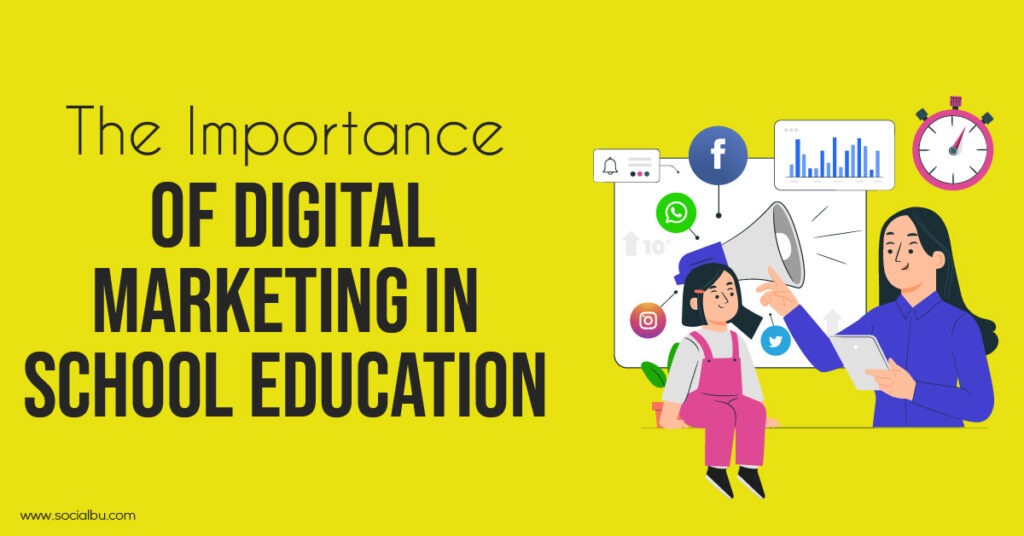Digital Marketing in School Education is paramount in today’s fast-paced digital age. It’s important for many fields, including schooling, to leverage technology. Digital marketing offers a flexible method to reach specific groups, revolutionizing how schools teach.
This piece delves into how digital marketing enhances learning and its potential implications for schools.
Definition of Digital Marketing
Digital marketing promotes goods, services, or educational institutions using:
- websites;
- social media;
- search engines;
- emails;
- online adverts.
Using digital tools, schools can connect well with kids, parents, and the community.
Overview of School Education and Technology

Technology is helping schools improve learning and communication. Technology has transformed teaching, making it more participatory and interesting. Gone are the days of static textbooks and one-size-fits-all lectures. Educators now have access to:
- a wealth of multimedia resources;
- interactive presentations;
- e-learning systems that accommodate different learning styles.
The use of technology in schools has made learning more fun and efficient. Students who use digital tools to learn are more involved in the process. This helps them remember what they have learned.
Additionally, for those seeking essay help online, these technological advancements have introduced real-time assessment and feedback mechanisms. They enable teachers to identify areas for improvement and adapt their teaching approach.
As technology continues to evolve, the potential for enhancing education becomes boundless. Schools should take advantage of these changes and teach students digital skills. They’ll need to do well in a technology-driven world.
The Role of Digital Marketing in School Education
Here’s how digital marketing in school education is redifining classrooms.
Enhancing Communication
Digital marketing in education enables seamless communication between schools and parents. Schools can share updates, notices of events, and progress reports.
Same as through email, instant messaging, and apps made for that purpose. This constant flow of knowledge makes it easier for teachers and parents to talk to each other.
Improving Parent-Teacher Interaction
In the past, parent-teacher meetings were limited to scheduled appointments. But marketing has transformed this aspect of school education by offering:
- virtual meetings;
- webinars;
- online conferences.
Parents can now participate in their child’s education, regardless of geographical constraints.
Personalized Learning Experience
Digital marketing lets schools tailor learning to student needs and styles. Personalized learning tools include adaptive learning platforms, virtual tutoring, and interactive educational games.
Benefits of Digital Marketing in School Education
Below are the benefits of how embracing digital marketing in school education opens the door to innovative teaching methods.
Access to a Wider Audience
Through digital marketing, schools can extend their reach beyond local communities. They can attract international and regional students with well-optimized websites and social media. Contributing to cultural diversity and enriching the learning environment.
Cost-Effectiveness and Efficiency
Digital marketing offers better ROI than traditional advertising. It allows schools to divide resources more and target specific demographics. It ensures their efforts focus on reaching the right audience.
Real-Time Analytics for Improvement
Digital marketing technologies allow schools to track strategy performance in real time. Schools can increase outreach through website traffic, social media engagement, and email open rates.
Challenges and Concerns
Let’s delve into the complexities of digital marketing in school education. Here are some key challenges and concerns.
Data Security and Privacy
With increased digital interactions, schools must focus on data security and privacy. Maintaining student and parent trust requires data security and compliance.
Digital Divide among Students
Not all students have equal access to technology, creating a digital divide. Schools must provide computers and internet connectivity to remedy this discrepancy. To ensure that every student has the opportunity to enjoy digital learning.
Overreliance on Technology
While digital marketing enhances education, an overreliance on technology may have adverse effects. To keep education effective, traditional and digital teaching techniques must be balanced.

Best Practices for Implementing Digital Marketing in Schools
Following are some of the most effective strategies ahead to integrate digital marketing in school education seamlessly.
Creating Engaging Content
Content is the heart of digital marketing. Schools should focus on making material that is useful and interesting to the people. This includes blog posts, videos, and other interactive media. That explains what the school has to give and what makes it special.
Utilizing Social Media Platforms
Social media platforms are powerful tools for school marketing. Schools can engage students, parents, and alumni on Facebook, Instagram, and Twitter. Sharing updates, event promotions, and student achievements builds community.
Integrating Online Learning Tools
Schools should use online learning tools as part of their education strategy to maximize digital marketing benefits. Top platforms like Podia and its alternatives offer virtual classrooms, educational apps, and e-learning platforms that provide interactive learning experiences complementing traditional teaching methods.
Future Trends in Digital Marketing for School Education
Following are some cutting-edge transformations that can redefine digital marketing in school education, driving innovative learning and engagement methods in the classroom.
AI and Personalized Learning
AI-powered educational software ensures educational material is tailored to each student’s needs. It can look at how people learn, their skills, weaknesses, and learning patterns to make it more personal.
Virtual and Augmented Reality Integration
Virtual and augmented reality technologies will transform the classroom experience. These immersive technologies can make virtual field trips and reenactments of historical events. Same as interactive models that make learning more fun and easy to remember.
Gamification for Educational Purposes
Gamification, which adds game factors to learning, will continue to grow in popularity. Schools can get students to actively participate in their learning by giving them tasks, rewards, and interactive parts.
Conclusion
Digital marketing has transformed schools’ communication with students, parents, and the community. Digital channels boost communication and personalize learning. Same as providing real-time statistics to help schools improve.
Digital marketing in education helps schools reach more people, save money, and maximize resources. Data security and pupil digital divide must be addressed. A holistic and effective learning environment requires balancing traditional teaching methods and technology.







